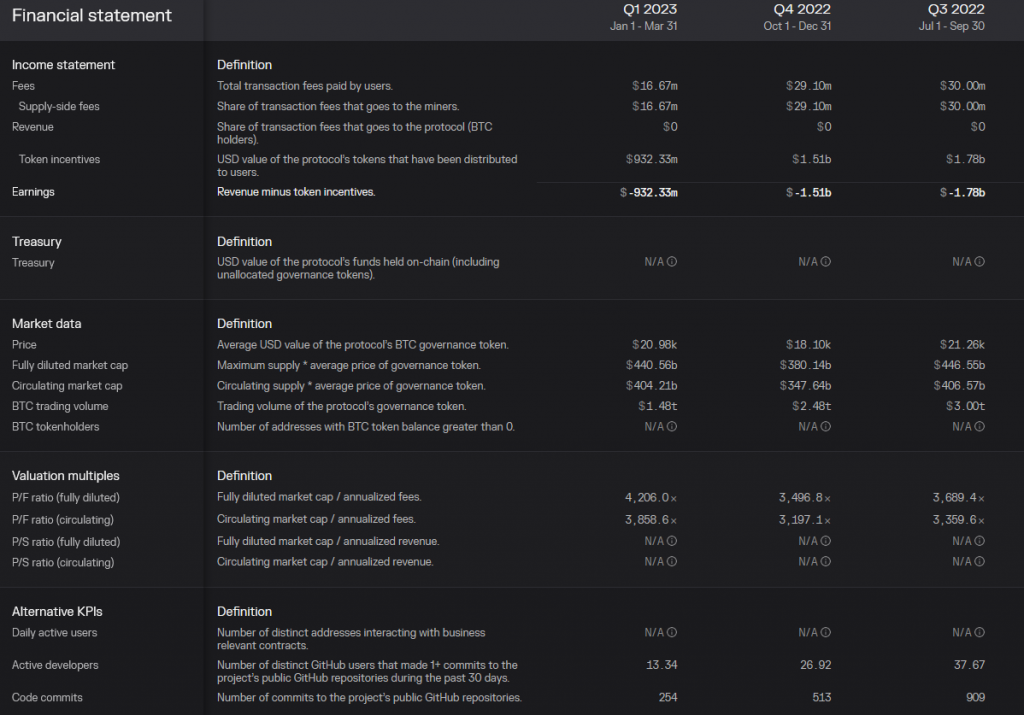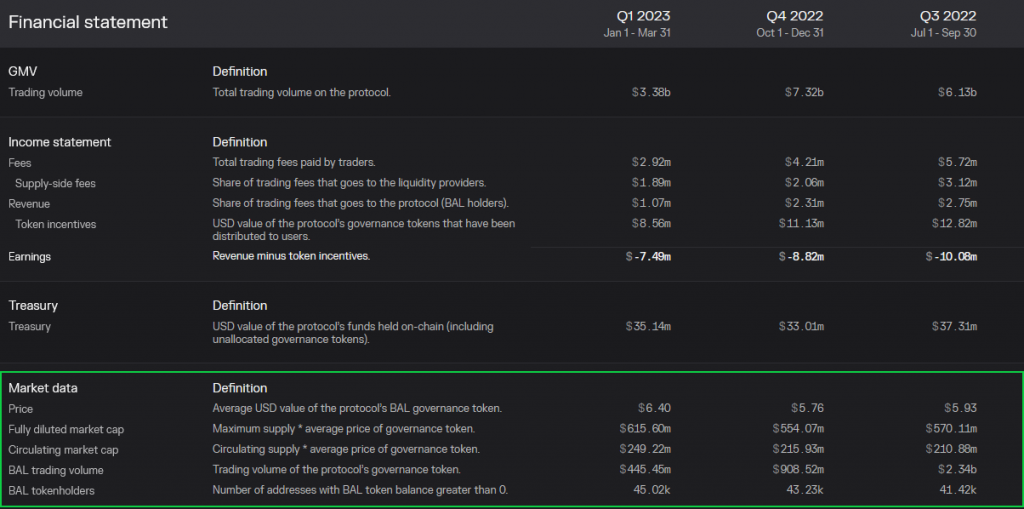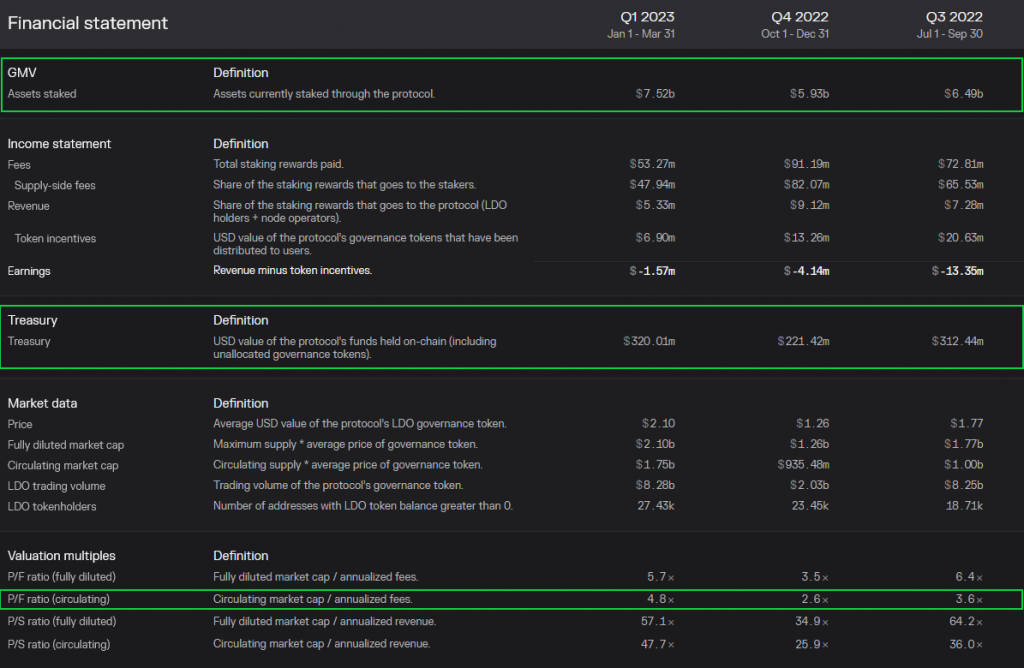
Summary: I talk about the mental game of investing, particularly as it applies to crypto markets. Subscribe here and follow me to get weekly updates.
This week, Token Terminal released one of the greatest crypto products I’ve seen in years: crypto financial statements. (See them here.)
The idea of creating crypto financial statements may have started with James Wang, who created one for Ethereum in Q1 2021. It was a clever concept: public companies are required to disclose their quarterly financials; why not do the same thing for crypto “companies”?
Since blockchain technology is transparent, these financial statements would be much better than those of traditional companies. They wouldn’t be prepared by an in-house financial team, shrouded in secrecy, and released weeks later. They would be available to anyone, instantly.
Now, Token Terminal has taken this one better: they’ve automated them.
The SEC, which prides itself on requiring clear and transparent financial information for investors, should be praising this latest development. This is so much better than the way it’s done with public companies.
I’ve been geeking out over these reports all week. As a long-term crypto investor, these financial statements are like a secret weapon. It cuts through the hype and the headlines, and gives you the cold, hard facts about any crypto project they have listed (currently about 150).
The best part? The product is completely free.
Today I’ll show you how to read crypto financial statements, and some of the quick numbers you can pull to see whether a crypto investment might be worth your hard-earned money.

Understanding the Income Statement
First, a caveat: Token Terminal needs to work on their token terminology.
If you’re used to reading traditional income statements, you’ll have to wrap your head around these confusing names, so I’ll break them down.
What they call “fees” is like a traditional company’s “revenue.” As every crypto investor knows, you have to pay fees to use crypto products. These fees are the money the crypto company takes in – like revenues of a traditional company.
“Supply-side fees” are the share of these fees that go to the miners or validators: the ones who maintain the network. In a traditional company, this might be like your salaries paid to employees, or what you pay to make the product (also known as Cost of Goods Sold, or COGS).
What they call “Revenue” is transaction fees that are paid to token holders, or (in some cases) tokens that are burned. Think of this more like “dividends” and “stock buybacks”: it’s revenue that’s benefiting the “shareholders” or “owners” (i.e., those who hold the token).
“Token incentives” are “extra rewards” paid to users to get them to use the product. Compound, for example, pays COMP tokens to lenders and borrowers. This encourages usage of the product, but continually dilutes the value of COMP for everyone else. This is a useful metric, and I don’t think there’s a public-company equivalent: it would be like if Uber paid stock to get you to use their product in the early days. (More info here.)
Finally, what they call “Earnings” are the aforementioned “Revenue” minus “Token incentives.” (Or value that accrues to shareholders, minus value that is taken away.) Earnings is incredibly valuable, even if it’s confusingly-named, because it tells you whether owners/shareholders are gaining value or losing it.
Here’s a quick reference guide:
| Term | What it is | Public-company equivalent |
| Fees | Money taken in from users of the product | Revenue |
| Supply-side fees | Fees that go to miners or validators | Salaries, COGS |
| Revenue | Value that is passed to token holders (fee-sharing or token burning) | Dividends, stock buybacks |
| Token incentives | Free tokens given to users for using the product | Discounts, rebates (but paid by issuing new shares) |
| Earnings | Token incentives minus earnings | Share dilution (or buyback) |
Let’s take a few real-life examples, and the “story” that you can tell from each. To tell the story, we read the statements from right to left, or past to present.
Bitcoin Income Statement

The story: Fewer people are using the bitcoin network over the last few quarters ($30 million to $16.67 million in fees), which is not surprising given what we know about the current market.
Calling the bottom line “Earnings” looks like the bitcoin company is losing money every quarter, which isn’t really accurate, but it does highlight an important point: all bitcoin fees are going to miners, and none to the owners (or BTC investors).
In these reports, negative Earnings are not necessarily bad. They just mean you (the owner/shareholder) are not getting additional value, on top of the value of your underlying BTC.
As an analogy, some traditional investors only want to buy companies that pay dividends. Others don’t care about regular payments, as long as the company has good long-term growth prospects. Bitcoin would appeal to the second type of investor.
Ethereum Income Statement

The story: A much better financial picture. Not only are fees (think: revenues) holding up, but earnings (think: the value of your investment) is going from negative to positive. This is a positive trend for ETH investors.
Uniswap Income Statement

We have a new metric here, which is the confusingly-named GMV, or “Gross Merchandise Volume.” While this sounds like something a clothing manufacturer would measure, GMV is really just how much money they are moving. On a decentralized exchange like Uniswap, it’s their trading volume. With a lending company like Compound, it’s the value of active loans.
The story: Total trading volume is down about half from two quarters ago – again, not a surprise in the current market. All the fees earned by Uniswap go to the liquidity providers (you can read more about LPs in our Investor’s Guide to Uniswap). As with bitcoin, UNI investors are betting on the company (i.e., that UNI price will rise), not on any payments to shareholders.
Understanding the Treasury
Forward-thinking crypto companies keep a “Treasury” – a bit like “retained earnings” for traditional companies – that can be used to grow the business.
You might use Treasury to create new developer incentives, fund related startups, pay executives, or anything else that might cost real money. (Even though it’s held in tokens, it can be converted into cash.) Communities usually vote on where to spend Treasury.
| Term | What it is | Public-company equivalent |
| Treasury | Funds set aside to grow the business | Retained earnings |
Here’s a look at Compound’s Treasury:
The story: When you see the Treasury slipping from $442 to $126 million (bottom row, right to left), you may think they are spending a boatload on what is clearly a declining business (top row, right to left).
However, everything is affected by the macro market: when crypto is down, the demand for loans is down. The same goes for the value of their Treasury: since it’s likely held in COMP tokens, the value of the token affects the value of the Treasury. Not a great financial picture, but more investigation is needed.
Which brings us to…
Understanding Market Data
You’re already familiar with “Price”: unfortunately, it’s the only metric most crypto investors use. (That’s why these reports are your secret weapon.)
They give you two market cap metrics, and the difference is how many tokens have been minted vs. how many have been promised:
- “Fully Diluted Market Cap” is the total value of the crypto company when all tokens are minted, according to their promised rules;
- “Circulating Market Cap” is the total value of all the tokens in circulation today.
“Trading Volume” shows you the value of tokens traded during the quarter, and “Tokenholders” tells you how many individual wallets hold the token (imperfect number, since people can hold more than one wallet, but probably close enough).
Here’s the Market Data for Balancer (BAL):

The story: Bucking market trends, the price of BAL has actually increased over the last few quarters, as have the number of BAL tokenholders. There are roughly $250 million in tokens issued, out of $615 million that can eventually be minted.
Looking at the total picture, we can see that even though trading volume (top line) has declined with the overall market, and earnings (think: shareholder value) are in the red, the price of BAL keeps going up. This is a red flag: why are investors so optimistic? (This may be the answer.)
Understanding Valuation Multiples
In the traditional world, a valuation multiple is a ratio of one financial metric to another. They’re useful for comparing very different companies, apples to apples.
These reports list four valuation multiples:
- P/F ratio (fully diluted): Fully diluted market cap / annualized fees.
- P/F ratio (circulating): Circulating market cap / annualized fees.
- P/S ratio (fully diluted): Fully diluted market cap / annualized revenue.
- P/S ratio (circulating): Circulating market cap / annualized revenue.
The most helpful here is probably P/F ratio (circulating), which gives you the total value of all tokens, divided by the fees (or revenue) generated. Think of this like P/E ratio in traditional investing.
(You’re probably wondering why they chose the letter “P.” It stands for “Price” in traditional Price-to-Earnings ratios. Super-confusing names, but great idea.)
| Term | What it is | Public-company equivalent |
| P/F ratio (circulating) | Total value of all tokens, divided by fees (revenue) | P/E ratio |
The rule of thumb is that stocks with higher P/E ratios are more overvalued, while those lower P/E ratios are more undervalued. As a value investor, we hope to buy good companies with lower P/E ratios: these are the “hidden gems.”
Here are the valuation multiples for Lido (LDO):

The story: We can see healthy financials, with a growing number of assets staked (top line), a growing Treasury, and a steadily increasing price.
The P/F ratio (circulating) has increased from 3.6x to 4.8x, showing you that LDO is not quite the deal it was back when we issued our BUY ALERT in July. But it is still remarkably low compared to many other crypto projects (Ethereum, for example, is selling at a 150x P/F ratio). Still might be a great buy.
Understanding Alternative KPIs
Finally, the Alternative KPIs gives you key information to gauge the health of the business:
“Daily Active Users” is like the number of loyal customers. DAU is one of the most important metrics in blockchain, due to network effects. (Please read our piece on Daily Active Users: Like X-Ray Vision for Crypto Investors.)
“Active Developers” and “Code Commits” shows you how many people are actually behind these projects. Think of this like the size of the tech team, and how many big changes they are making each quarter.
Let’s compare these metrics for bitcoin and Ethereum:


The story: You’ll be surprised to learn that bitcoin had only 13 active developers last quarter, while Ethereum had 165. The team made just 250 changes (code commits) for bitcoin, versus 2,000 for Ethereum.
This paints a picture of Ethereum as a growing, vibrant ecosystem, with bitcoin a tiny squad of developers keeping the lights on. (And as the Wall Street Journal reported today, this is indeed the case.
Putting it All Together
These financial reports are a significant milestone for the crypto industry. They’re not perfect. They could be more intuitive. But they’re the start of something really great: a picture of financial health over time.
No more do we have to rely on hype and headlines to make investing decisions: we can now evaluate the businesses ourselves, using reason and reporting over FUD and FOMO.
These reports are still a work in progress, since there are no Generally Accepted Accounting Principles (GAAP) for crypto. In fact, most people won’t even admit that cryptos are companies. Which is why these reports are a godsend for the serious crypto investor.
We’ve been saying for years the obvious truth: even if they’re not technically companies, we can think of cryptos like companies. With these new financial reports, we now have a powerful new tool to evaluate their corporate performance.
It’s the crypto investor’s secret weapon.
50,000 crypto investors get this column every Friday. Click here to subscribe and join the tribe.
Source: https://www.bitcoinmarketjournal.com/how-to-read-crypto-financial-statements/


